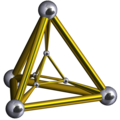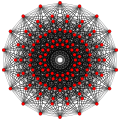Top Qs
Timeline
Chat
Perspective
6-demicube
Uniform 6-polytope From Wikipedia, the free encyclopedia
Remove ads
In geometry, a 6-demicube, demihexeract or hemihexeract is a uniform 6-polytope, constructed from a 6-cube (hexeract) with alternated vertices removed. It is part of a dimensionally infinite family of uniform polytopes called demihypercubes. Acronym: hax.[1]
E. L. Elte identified it in 1912 as a semiregular polytope, labeling it as HM6 for a 6-dimensional half measure polytope.
Coxeter named this polytope as 131 from its Coxeter diagram, with a ring on one of the 1-length branches, ![]()
![]()
![]()
![]()
![]()
![]()
![]()
![]()
![]() . It can named similarly by a 3-dimensional exponential Schläfli symbol or {3,33,1}.
. It can named similarly by a 3-dimensional exponential Schläfli symbol or {3,33,1}.
Remove ads
Cartesian coordinates
Cartesian coordinates for the vertices of a demihexeract centered at the origin are alternate halves of the hexeract:
- (±1,±1,±1,±1,±1,±1)
with an odd number of plus signs.
As a configuration
This configuration matrix represents the 6-demicube. The rows and columns correspond to vertices, edges, faces, cells, 4-faces and 5-faces. The diagonal numbers say how many of each element occur in the whole 6-demicube. The nondiagonal numbers say how many of the column's element occur in or at the row's element.[2][3]
The diagonal f-vector numbers are derived through the Wythoff construction, dividing the full group order of a subgroup order by removing one mirror at a time.[1]
Remove ads
Images
Related polytopes
Summarize
Perspective
There are 47 uniform polytopes with D6 symmetry, 31 are shared by the B6 symmetry, and 16 are unique:
The 6-demicube, 131 is third in a dimensional series of uniform polytopes, expressed by Coxeter as k31 series. The fifth figure is a Euclidean honeycomb, 331, and the final is a noncompact hyperbolic honeycomb, 431. Each progressive uniform polytope is constructed from the previous as its vertex figure.
It is also the second in a dimensional series of uniform polytopes and honeycombs, expressed by Coxeter as 13k series. The fourth figure is the Euclidean honeycomb 133 and the final is a noncompact hyperbolic honeycomb, 134.
Skew icosahedron
Coxeter identified a subset of 12 vertices that form a regular skew icosahedron {3, 5} with the same symmetries as the icosahedron itself, but at different angles. He dubbed this the regular skew icosahedron.[4][5]
Remove ads
References
External links
Wikiwand - on
Seamless Wikipedia browsing. On steroids.
Remove ads













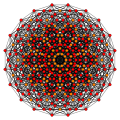
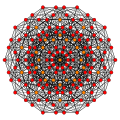
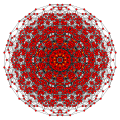
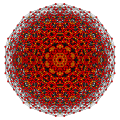


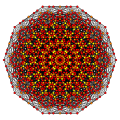
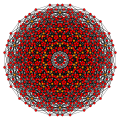
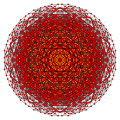




 ,
,  ...
...